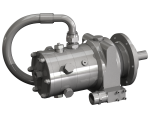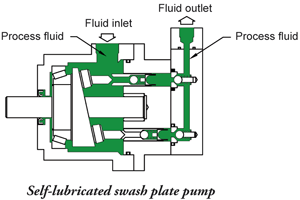
Comparison of pump types
Pumps for water-based and chemical fluidsMany applications demand pumps for pumping water-based (e.g., water/glycol) and chemical (e.g., methanol) fluids. Here we examine and contrast three types of such pumps. A first alternative is a large gearbox and crankshaft driven pump, sometimes known as triplex pump design (when 3 pistons incorporated). A pump of this magnitude may be the only alternative for high flow rates to be delivered at very high pressures (over 1,000 bar), but for applications demanding pressures of 700 or 800 bar or less, these pumps are overly massive. The pump itself demands a large amount of skid space; futhermore this type of pump typically requires an external lubrication supply and is driven by a separate motor through an intricate gearbox arrangement making yet further demands on skid space. Maintenance of such a complex engineered product can be a challenge while with a painted cast iron casing, corrosion needs to be monitored. |

|
 |
A much more compact alternative is provided by a swash plate design with a single swash plate driving 2, 3, 4 or 6 pistons. The modular design can be configured to provide flow rates up to 187 l/m at 155 bar or pressures of 636 bar at 46 l/m. Indeed, this design provides a very high performance to weight ratio. The small footprint can easily be accommodated within an overall system – with no external pumps as the swash plate pump is self-lubricating. The pump is driven directly by an in-line motor and is typically made of corrosion-resistant 316 stainless steel. |
|
Marshalsea Hydraulics manufactures swash plate pumps with lubrication provided by lubricating oil in a separate chamber, remote from the process fluid being pumped. A third type of pump that is offered is a swash plate design similar to Marshalsea’s, but with one striking difference – the use of the process fluid itself to lubricate the moving parts. This is acceptable for oil pumps, but not for water-based or chemical fluids – the process fluid is in direct contact with corrodable carbon steel components and not contained within corrosion-resistant material. Wear debris from the pump contaminates the process fluid directly and the pump is not tolerant to prolonged dry running as is required for ATEX compliance. |
 |